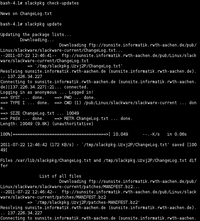Linux Basics/Fundamental concepts in Linux
Distributions
[edit | edit source]By itself Linux is a Kernel - the core component of an operating system. However other components are required to make a full operating system. A Linux Distribution, or Distro for short, includes all the components needed to form a full operating system. Because there are a number of different component options to choose from, each Linux distro offers a unique spin on Linux, and are often specialized for handling certain tasks.
Distribution components
[edit | edit source]User Interface / Shells
[edit | edit source]Command Line Interface
[edit | edit source]- BASH
- ZSH / Z Shell
Graphical User Interfaces
[edit | edit source]Desktop Environments
[edit | edit source]- KDE, Gnome, MATE, Xfce, Cinnamon, LXDE, LXQt, Pantheon, Budgie stb.
Desktop Managers
[edit | edit source]- Desktop Managers: SDDM, GDM, LightDM
Package Manager
[edit | edit source]RPM: Red Hat, Fedora, CentOS, openSUSE stb.
DEB: Debian, Ubuntu, Linux Mint, MX Linux stb.
repository: container; programs and drivers can be found for the distros
package manager: it solves the dependency tree if there is an compatibility issue.
Common distributions
[edit | edit source]Red Hat Enterprise Linux
[edit | edit source]

Red Hat Enterprise Linux (RHEL) is one of the most successful Linux distributions which is developed by Red Hat for commercial usage.
Official support for RHEL is available, and while support costs money, it is generally well regarded.
Package Manager: RPM - RHEL is the original home of RPM, and remains heavily associated with it.
Default User Interface: GNOME
Fedora
[edit | edit source]

Fedora is a community distro associated with RHEL.
Unlike Red Hat Enterprise Linux, Fedora is gratis, costing no money.
Cutting edge features are often implemented in Fedora before they are added to RHEL.
Package Manager: DNF (RPM based), Flatpak
Default User Interface: GNOME (Wayland based)
Slackware
[edit | edit source]

Slackware is the oldest Linux distribution under active development. The first version was released in 1993, based on the wide spread SLS Linux, and used floppy disks as an installation medium in the beginning.
Slackware pursues simple usability, stability and security as its main goals. It doesn't have automatic dependency handling. The aim since its release to become the most Unix-like Linux distribution.
Package Manager: slackpkg
Default User Interface: Bash
Debian
[edit | edit source]

Debian is one of the oldest Linux distros. It was announced on August 13, 1993 by Ian Murdock. The word Debian comes from Debora (Ian's wife) and Ian's name.
Debian is not commercially oriented. In contrast to RHEL, the distro is driven by volunteers.
Debian is a solid and reliable operating system. Because of this, it serves as the foundation of many distributions like Ubuntu and Knoppix.
Package Manager: APT (dpkg)
Default User Interface: GNOME or XFCE
Ubuntu
[edit | edit source]

Ubuntu is one of the most popular distributions, which has been developed by Canonical Ltd. since 2004.
The first release was 4.10 and since then, in every 6 month a newer version and in every 4th month of even year a Long-Term Support releases.
Package Manager APT, Snap
Default User Interface GNOME
Arch Linux
[edit | edit source]
Arch Linux is an independent distribution for advanced Linux users.
It has rolling-release model, which means that it updates continuously instead of bigger releases.
Package Manager Pacman - Arch's own package manager
Default User Interface Bash
OpenSUSE
[edit | edit source]

OpenSUSE is the sequel of SUSE Linux and it's a project which promotes of using Linux ensuring by this a free and complete distribution to the users.
Package Manager: ZYpp
User Interface: Selectable from major GUIs on install, including GNOME, KDE, and XFCE.
Gentoo
[edit | edit source]
Gentoo Linux is a flexible, fast distribution using Portage package manager.
In contrast to other distributions, you have to compile the whole system from source, so the installation process may take hours depending on hardware.
Package Manager: Portage
Default User Interface: Bash
Tux the Penguin
[edit | edit source]
The mascot of Linux is Tux, the penguin, which was planned by Alan Cox and Linus, and was drawn by Larry Ewing.[1]
History
[edit | edit source]Why Linux? Linus Torvalds showed that MINIX isn't available for x86(it was only available for education purposes), so he programmed a kernel for x86.[2]
In 1991 Linus Torvalds was sophomore student in University of Helsinki at the faculty of Computer Sciences. He was a self-educated hacker, and wanted to write his own operating system, so he decided to write one. Why? He wanted to explore the Intel 80386 CPU's protected mode, task-switching capabilities. That was around the summer of 1991.
GPL - The GNU General Public License is a widely used free software license, which was created by Richard Stallman for the GNU Project. The aim of GNU GPL is to grant the copying and distributing of free software ensuring the free use of the software for every user.
Linux is surrounded by shells - command prompts, and X Window System can be built on it.
What are Linux distributions/distros? Operating systems that has Linux kernel under the hood. Under the list there are some examples. You can find all the others on Distrowatch.com with ratings for each one.
